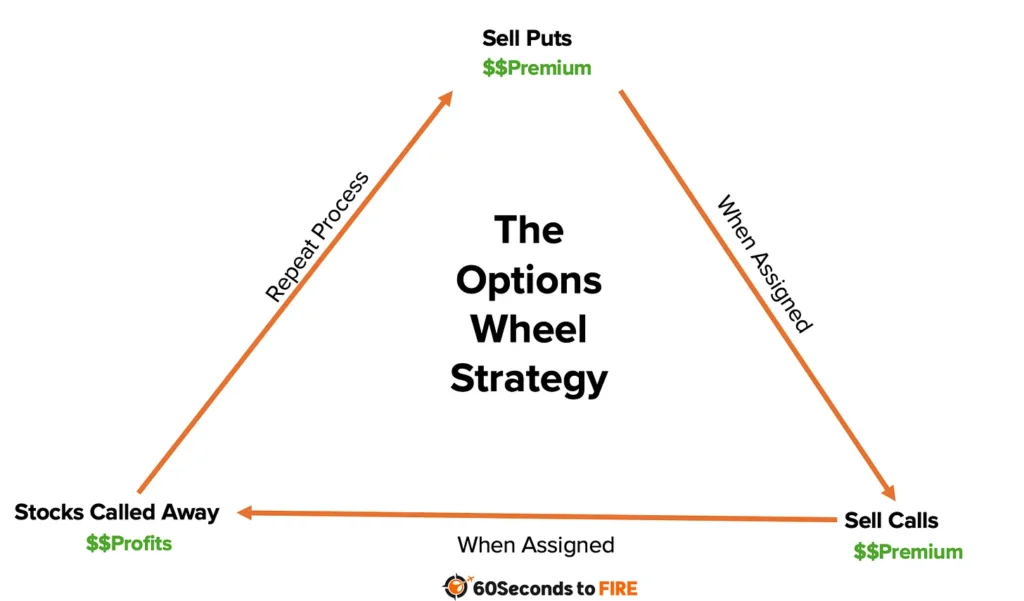Hey Geo-Fire Fams!
A small treat for you this week. A strategy for using both Calls and Puts in a beautiful harmony that will see notes of cash fall melodically into your investment account.
This week i’m chatting to you about the Wheel Strategy.
Now before we jump into it, if you haven’t read my previous posts on using Covered Calls and Cash Secured Puts for generating passive income, click the links provided. Now, let’s dive into it!
Briefly, Options trading isn’t just a tool for experienced investors—it can also be a powerful way to generate passive income that supports your long-term financial goals, including an early and extraordinary retirement. Personally, this is one of my favourite aspects of Options Trading as it allows me to earn cashflow whilst growing my portfolio at the same time. Win Win!
The Wheel Strategy
One of the most effective strategies for this is the wheel strategy, a method that allows you to generate income in any market condition while building wealth over time. When paired with geo-arbitrage—relocating to a country with a lower cost of living—this approach can help you retire years, or even decades, earlier while maintaining a high quality of life. In this article, we’ll break down the components of the wheel strategy, explain how it works, and show how it can be a cornerstone of your financial plan, allowing you to enjoy a sustainable and fulfilling retirement without dipping into your juicy portfolio.
First let’s recap, for those that haven’t read the other articles in the passive income series.
An Option is a financial contract that gives the buyer the right, but not the obligation, to buy or sell an underlying asset at a specific price by a set date. For the seller, an option is an obligation to fulfill the terms of the contract if the buyer chooses to exercise it. Sellers of options collect a premium for taking on this obligation, creating the foundation for earning income. This premium is the regular income that we are looking for to cover our living costs whilst our portfolio grows untouched.
A Covered Call is a strategy where an investor owns or controls 100 shares of a stock and sells a call option on them. The call option obligates the seller to sell the shares at the strike price if the buyer exercises the option. By selling covered calls, investors can collect premiums while still holding the underlying shares.
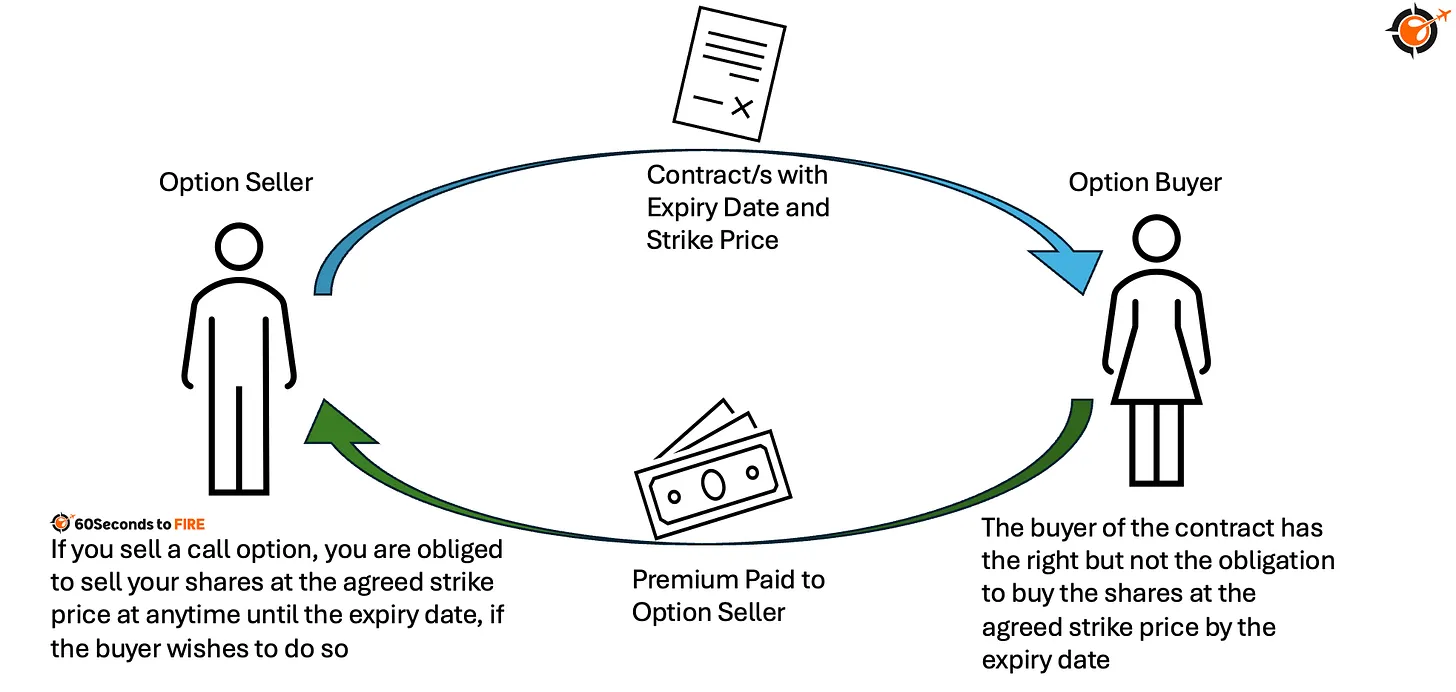
For example, imagine Sarah owns 100 shares of Company X, currently trading at $50 per share. She sells a call option with a strike price of $55 and collects $2 per share in premium. If the stock stays below $55, Sarah keeps the premium and her shares. If the stock exceeds $55 at the time of expiry, her shares are sold at that price, allowing her to lock in gains.
Sarah – Covered Call Returns
- If the stock is not assigned: This represents a cash-on-cash return of 4%.$2 x 100 (shares) = $200 premium and she keeps her shares.
- If the stock is assigned: This represents a cash-on-cash return of 14%. $2 x 100 (shares) = $200 premium and $5 x 100 =$500 capital gain (difference between cost and sale price). So all up $700. Not bad.
A Cash-Secured Put involves selling a put option on a stock the investor is willing to buy. The put option obligates the seller to buy the stock at the strike price if assigned. This strategy generates income through the premiums received while potentially acquiring stocks at discounted prices.
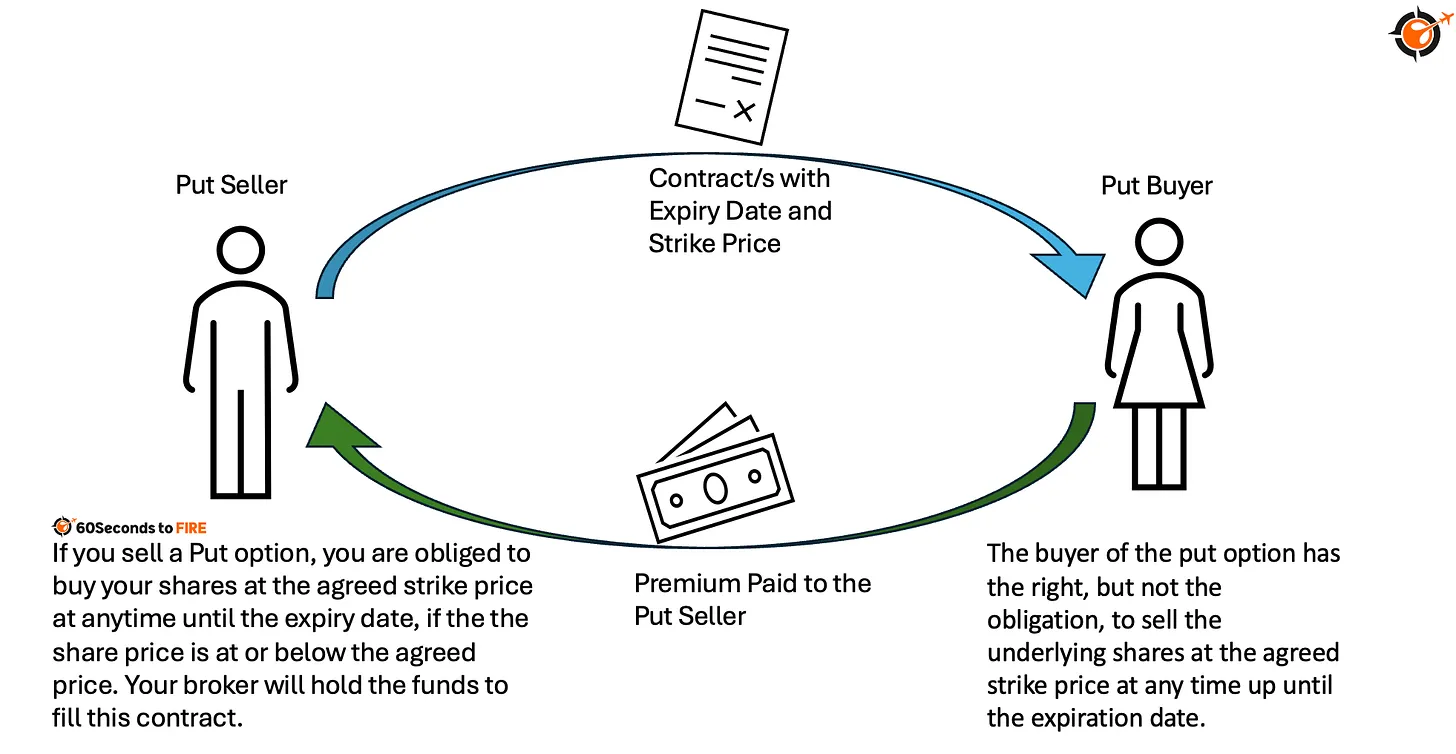
Let’s consider John, who is eyeing Company Y, trading at $40 per share. He sells a put option with a strike price of $35, collecting a $1 premium per share. If the stock stays above $35, John keeps the premium without purchasing the stock. If it falls below $35 at the time of expiry, he buys the shares but at an effective cost of $34, factoring in the premium.
Case Study 2: John – Cash-Secured Put
- If the stock is not assigned: $100 income, 2.86% return. $1 x 100 Shares.
- If the stock is assigned: $100 income and 100 shares with a cost basis of $34 each.
The wheel strategy combines these two techniques into a continuous income-generating cycle. It begins by selling a cash-secured put on a stock you wouldn’t mind owning. If the stock price drops below the strike price and you’re assigned, you purchase the shares. Then, you sell covered calls on those shares. If the stock rises and your shares are called away, you sell another cash-secured put and repeat the process.
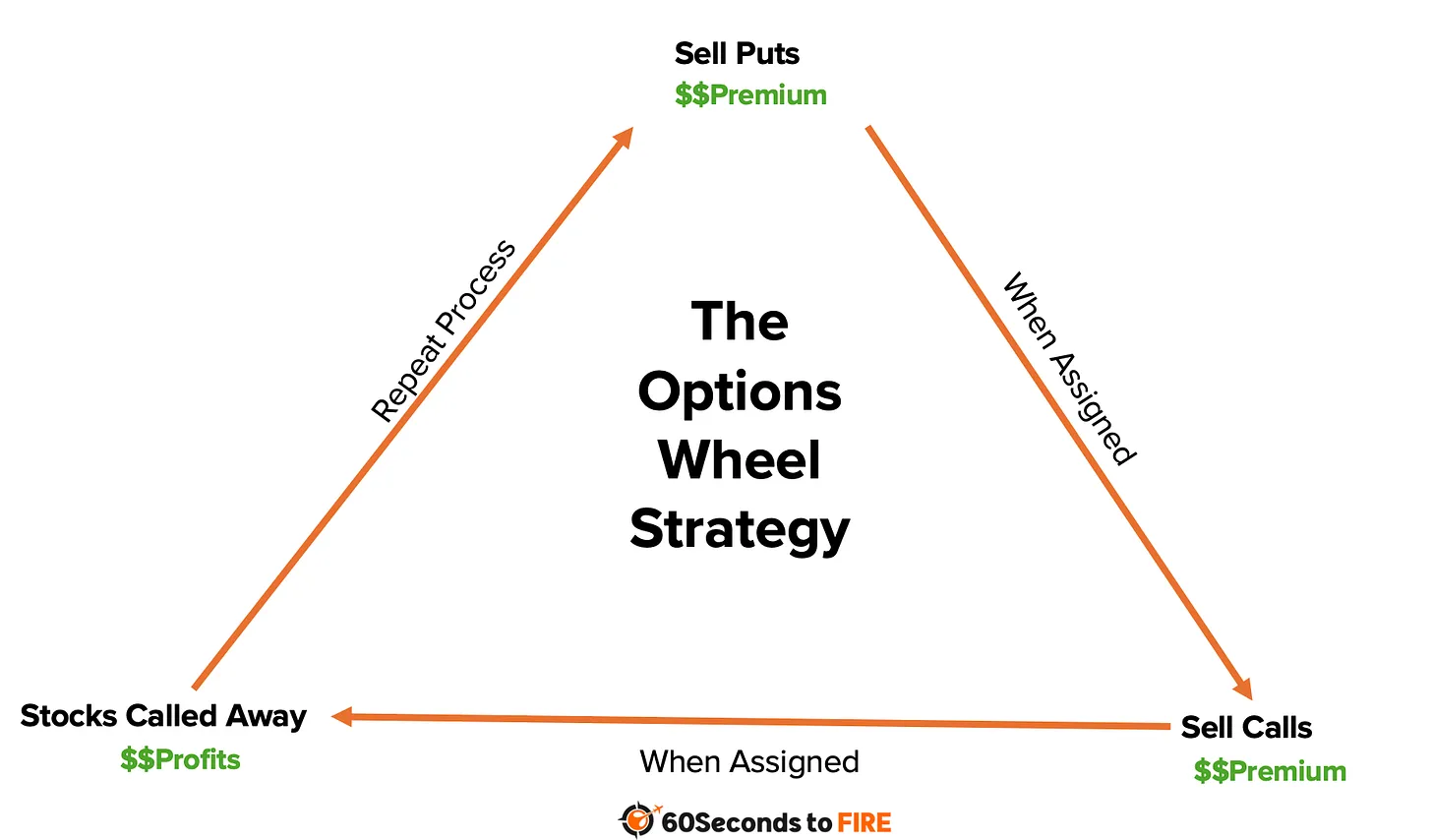
A cheeky diagram to demonstrate the Wheel Strategy. A simple and effective income machine.
Case Study 3: Tom – Using the Wheel Strategy
Part 1: Cash Secured Put
Consider Tom, who starts by selling a cash-secured put at a strike price of $48 on Stock Z which at the time had a $50 market price, collecting $2 per share.
- Cash-Secured Put (if the stock is not assigned): This represents a cash-on-cash return of 4.1%. – $200 / $4800 used to generate it.
But let’s say, at expiry, Stock Z is $47. That’s below the $48 Strike Price, and Tom is assigned the shares at the agreed $48 per share.
- Cash-Secured Put (if the stock is assigned): Tom makes 4.1% CoC return but this time, Tom also owns 100 shares at a lower cost basis of $46 ($48-$2 in premium). He is now set to move onto the next step of the Wheel Strategy, a Covered Call.
Part 2: Covered Call
Tom then sells a covered call with a $55 strike price, collecting another $2 per share and lowering the shares cost basis again. The new cost basis is $44 each.
- Covered Call (if the stock is not called away): This represents a cash-on-cash return of 4.5%. $2 x 100 shares / $4400 cost basis.
At expiry, Stock Z has climbed to $56, and Toms shares are called away. Tom repeats the cycle with a new put option.
- Covered Call (if the stock is called away): This represents a cash-on-cash return of 24%. $2 x 100 shares / $4400 cost basis plus the 55 strike price – $44 cost basis per share, or $11 difference x 100 shares. This means that under these conditions Toms makes $1100 if his shares are called away, a 24% CoC return.
Benefits
The wheel strategy offers several benefits. It generates consistent income from premiums, even in flat or declining markets. It allows investors to acquire stocks at prices they’re comfortable with while simultaneously profiting from rising stock prices through covered calls. Over time, this strategy can enhance portfolio returns significantly.

Risks
No strategy is without risk. One risk with the Wheel strategy is being assigned shares in a stock that continues to decline, which could result in unrealised losses. To mitigate this, focus on quality stocks with strong fundamentals that you’re comfortable holding long-term.
Another risk is missing out on significant upside if a stock rallies far beyond the covered call’s strike price. While the upside is capped in such scenarios, this can be mitigated by selecting higher strike prices for calls to leave room for potential appreciation.
Lastly, the strategy requires sufficient capital, particularly for cash-secured puts. This limits its accessibility for smaller accounts. To mitigate this, consider starting with lower-priced stocks or using index ETFs with manageable price points.
In Summary
The wheel strategy is a highly effective way to generate consistent passive income through options trading. By cycling between cash-secured puts and covered calls, you can earn premiums, acquire shares at discounted prices, and benefit from capital gains in rising markets. This type of income generation is particularly useful for retirement planning, as it provides a reliable stream of cash flow without requiring you to touch your principal investments. When combined with geo-arbitrage—relocating to a country with a lower cost of living—the income from the wheel strategy can go even further. This approach allows you to retire earlier, enhance your quality of life, and explore new opportunities while maintaining financial stability. By leveraging the wheel strategy alongside geo-arbitrage, you can create a retirement lifestyle that is both financially secure and truly fulfilling.
Cheers
Andy
Panama City, Panama
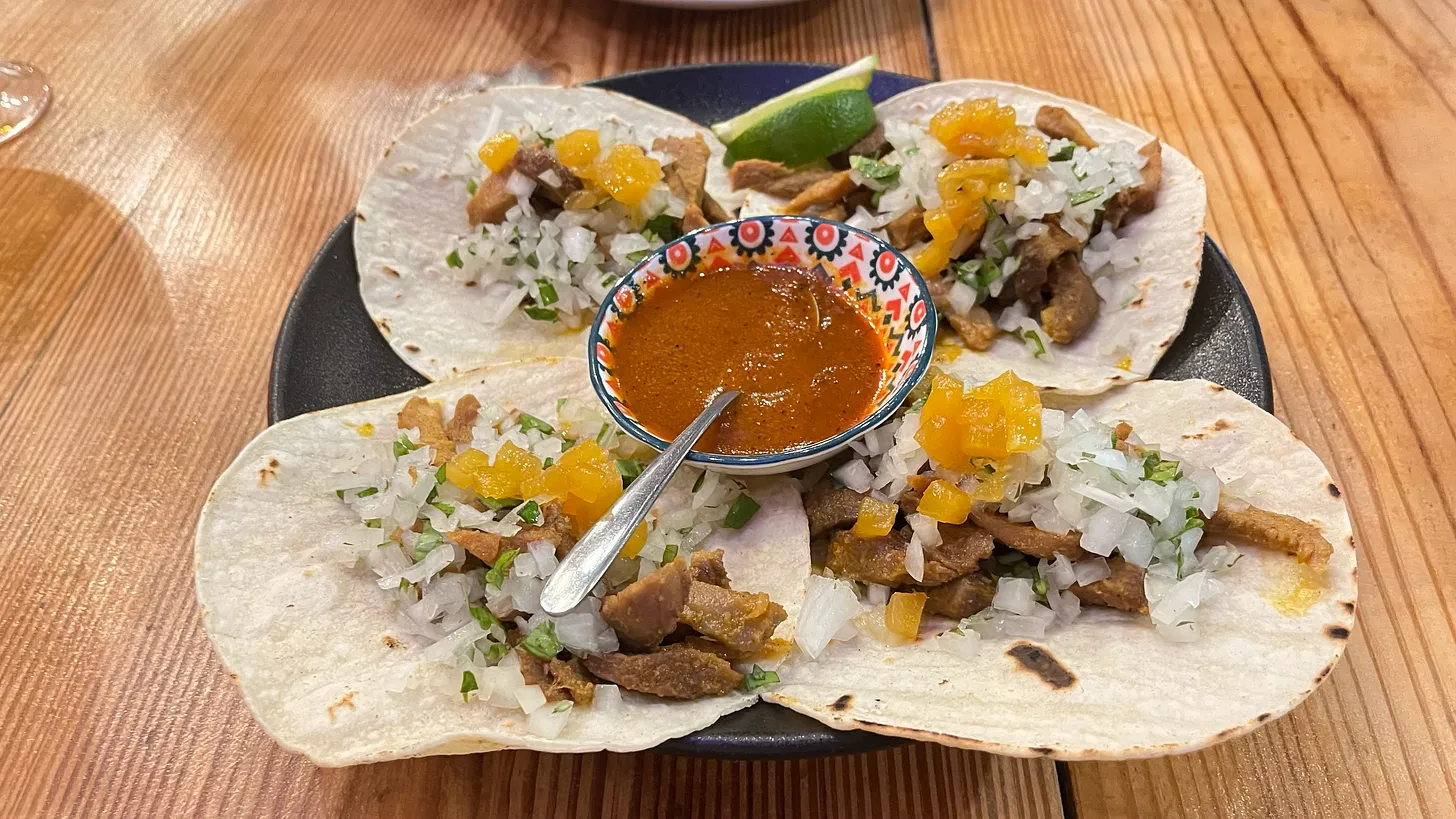
Taco time in Panama!

